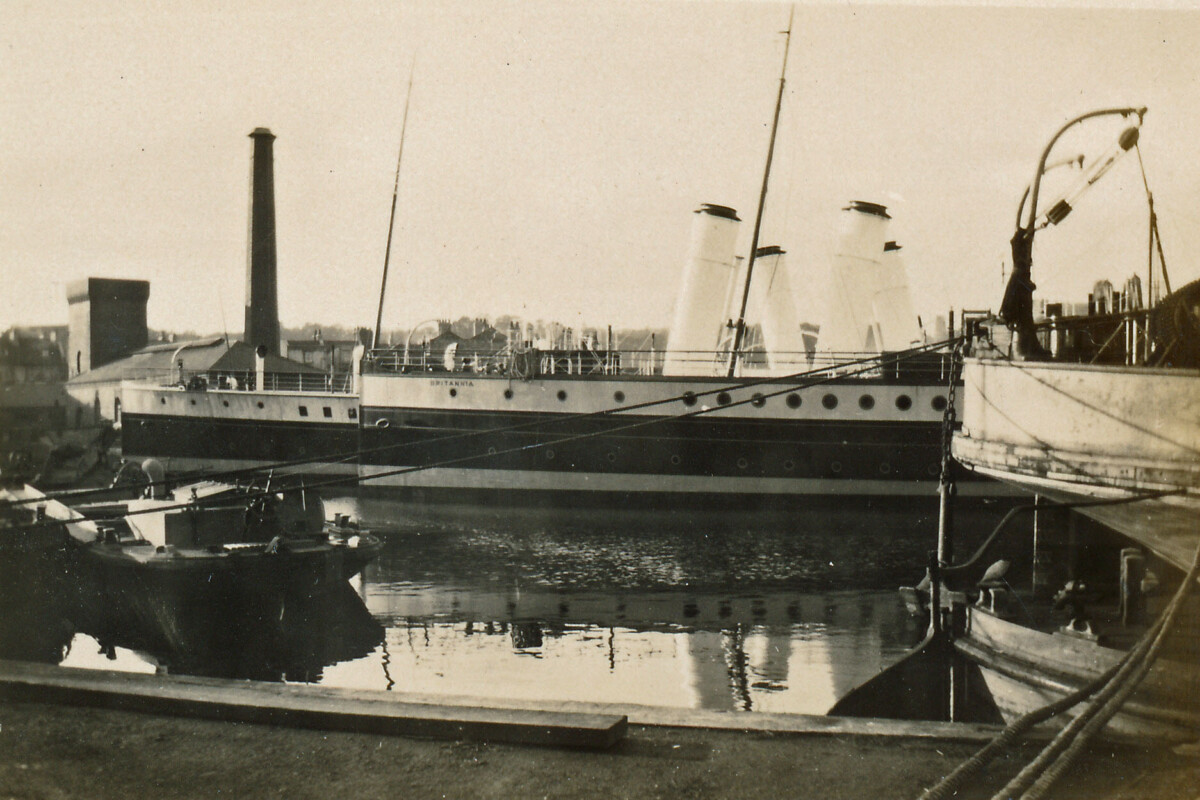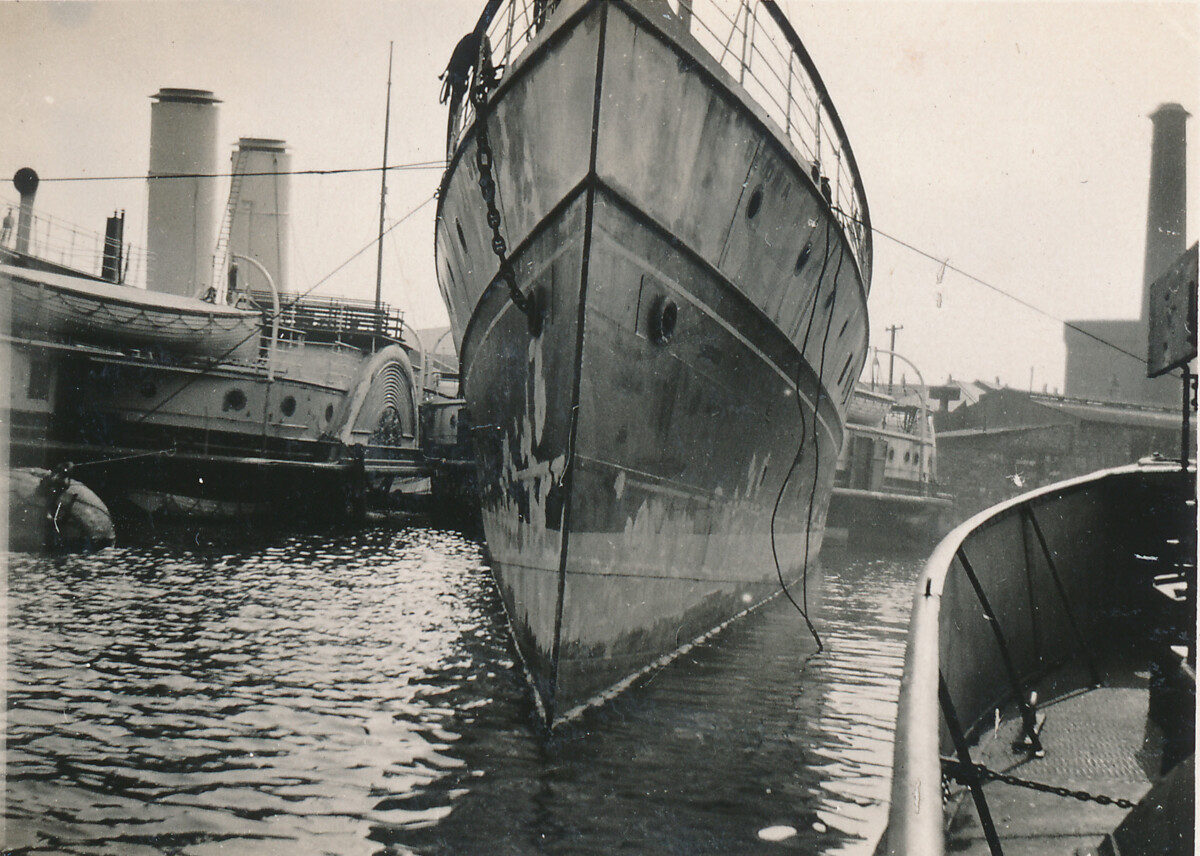
Lady Moyra Brit and Westward Ho moored at Underfall Yard in 1928
Volunteer writer Dave Duggan continues his series on P&A Campbell, the paddle-steamer business that was based at Underfall Yard in the early 20th century. This month, he explores the maintenance of the company’s highly popular fleet of paddle steamers and the innovative steps taken during their time at Underfall Yard.
Thank you to the Paddle Steamer Preservation Society for providing the featured photographs from their collection.
The brothers Peter and Alexander Campbell started their Bristol based paddle steamer business in 1887. Over the next 69 years their fleet of paddle steamers provided leisure cruises and ferry services from Bristol to destinations in Somerset, Devon, South Wales, along the South coast and across to France. For most of those years the Company’s head office was Britannia Buildings in the Cumberland Basin and Underfall Yard hosted their repair and maintenance facilities.
Beginning with the Waverley charter in 1887 the Campbells’ steamer fleet grew rapidly to 13 by the start of WW1. Daily use of the steamers during the excursion season from May to end of September resulted in the need for regular maintenance and repairs to their engines, boilers, hulls, fixtures and fittings above and below decks. The complex paddle systems were damaged by strong winds, rough seas and occasional collisions with piers and other steamers. During the winter months when the steamers were laid up around the floating harbour the more extensive repairs such as boiler and funnel replacement and routine repainting could be carried out.

Devonia moored at Underfall Yard in 1928
These types of repairs and maintenance required many types of engineering and craft skills. For example, metal workers, foundry operators, pattern-makers, electricians, carpenters, plumbers, boiler makers and many more. The work had to be carried out to high standards to cope with the intense daily use during the summer season and to ensure that the tens of thousands of passengers were provided with a luxury experience. A day out on the sea with “silver service in the restaurant, gleaming brass and varnished wood all at a very affordable price”. These passenger expectations were matched between the two world wars by Campbell’s engineering standards being widely recognised as the “finest in Bristol”.
Most repairs in the early days were carried out by local business around Bristol’s Floating Harbour. This included Charles Hill and Son Ltd, who were based at Albion Dock near the SS Great Britain. Albion Dock was the only dry dock large enough to accommodate the Campbell steamers. Some work was also carried out by the Underfall Yard workshops of the City Council Docks Committee which was (and still is) responsible for repairs and maintenance to the docks and floating harbour.
However, information at Bristol Archives shows that the Campbells were soon planning to do some of their own maintenance.[1] A lathe was bought for £28 in 1894 and a boring machine “for use in the stores” in 1906.
Underfall Yard had been a centre of engineering expertise since the 1880s when the Docks Committee granted permission for the creation of a purpose-built maintenance facility for the City Docks and Floating Harbour. So when in 1917 the Docks Committee agreed to lease part of Underfall Yard to P&A Campbell, the range of engineering activity at the Yard was significantly expanded.
The initial seven year lease at a rental of £250 pa included the buildings on both sides of the slipway. Over the following 40 years the lease was extended and modified several times resulting in the Campbells occupying the “Big Shed”, the old boiler house (now the Visitor Centre and Cafe) and other buildings in the area towards Nova Scotia Place. Several new buildings were also erected during this time including a shipwrights workshop and a foundry built on what is now the Scouts dinghy storage area on the Knuckle.
At Underfall Yard the Campbells (under the name “Campbell & Banks”) were also manufacturing highly sophisticated piston rings and packing to improve marine engine efficiency. The designs were innovative and based on a series of patents registered by Peter Campbell and Bill Banks between 1913 and 1923. Advertising material from 1935, from the Science Museum’s archive, shows details of the designs and a long list of customers in the shipping and maritime engineering businesses including the Admiralty.
If you, your friends or family have any memories or information about engineering work at Underfall Yard or P&A Campbell Ltd from 1900-1956, Underfall Yard Trust would like to hear from you. Email clv@underfallyard.co.uk or phone on 0117 929 3250.
This article was written by volunteer Dave Duggan and reviewed by Underfall Yard Trust. Click here to read more about the Yard’s volunteering program.
The Recovery and Reinstatement Project is now underway after the fire in May 2023. Click here to read more and find out how to support the project…
[1] The location of the Campbell’s repair facilities at this time is not clear but, in 1915, there may have been a workshop in “Rownham Yard”.
